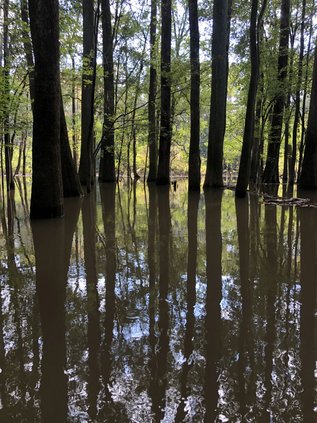A month ago, my family and I traveled on a two-week, 14-state road trip. It was long … and beautiful. Our goal was to get to three national parks: Shenandoah in Virginia, Acadia in Maine, and New River Gorge in West Virginia. With a pivot in the middle of the trip, we made it to the first two of the three.
National Parks are important to our family. I wish I had been exposed to them earlier in my life, but I give thanks that my spouse was and has a deep appreciation for the gifts they bring to the diverse landscape of the United States. We now hope to give our son as many opportunities exploring the vast range of beauty that exists in the parks while we still have that chance.
A few years ago, in the middle of Covid, we made it to one of the least visited parks, Congaree National Park, in Hopkins, South Carolina near the state capitol of Columbia. It just so happens that my parents live near there, and I had read an article in the New York Times highlighting lesser-known parks to visit as a Covid activity. Congaree was one of four featured, so the next time we made our way to my parents, we took a side trip and spent a hot October afternoon hiking there.
There is an amazing biodiversity that exists at Congaree, including the largest intact expanse of old growth bottomland hardwood forest remaining in the southeastern United States. Some of the trail floods throughout the year, including even the bridges that have been built along the walking path. My favorite part was these lush cypress trees growing in the floodplain forest, many estimated to be as old as 500 years. As you can see in the picture included, the water reaches the knees of the trees and the reflection of these elder trees in the water is just stunning.
We learned that around the end of May each year synchronous fireflies appear in large numbers and light up the night for those visiting. Their beauty and this phenomenon have become so significant that the park now must limit the viewing to 120 vehicles per night during the viewing events. Getting tickets to one of these coveted viewing events is now one of my goals!
Our road trip this summer continued our pilgrimage to national parks, and along the way, we were able to see the beautiful, quirky, and complicated parts of the United States. We drove by the giant peach outside of Gaffney, South Carolina near my hometown and explained to Sam why South Carolinians think they have the best peaches. We did a ghost tour in Philadelphia and learned some obscure history along the way too. We hiked two very busy national parks taking our time and breathing in the splendor and geographic diversity of them both. We spent a day at Monticello, Thomas Jefferson’s Virginia estate, and talked with our son about the complexity of his life, especially as it related to slavery.
There is much to see where we live, and we do not have to travel far to see it. Georgia, I have learned in my thirteen years here, has a rich landscape. It is also quirky and complicated, much like my home state of South Carolina. It is not only good for us to learn more about it and visit these places if we are able, but it is incumbent on us to expose those coming after us to it as well.
That is why I am excited about a trip I will get to offer our college students at the end of this academic year. We are finally able to return to our travel program, Global Connections, which is designed to help students connect the ways in which they make meaning in the world with justice issues such as peace, poverty, and the environment. Along with an anthropology professor, I will take students to Georgia’s coast to explore its history, food, and sustainability. We will travel around four of its barrier islands: St. Simons, Jekyll, Sapelo, and Cumberland. From busiest to more isolated, we will give a group of 18–20-year old’s an opportunity to learn about a place and people they may have never known otherwise.
As schools are back in full swing and our children and youth are embracing their education, my hope is that we all remember that education is a lifelong process. I hope you will have some opportunities to be outside in the beauty of our Georgia landscape. To learn our history and present civic environment as we move toward election season.
May the beauty you find inspire you. May the quirky pique your curiosity for continued learning. And may you be brave enough to confront the complicated and let it move you into action this fall.
The Rev. Lyn Pace is a United Methodist minister and college chaplain who lives in Oxford with his spouse and 9-year-old.






